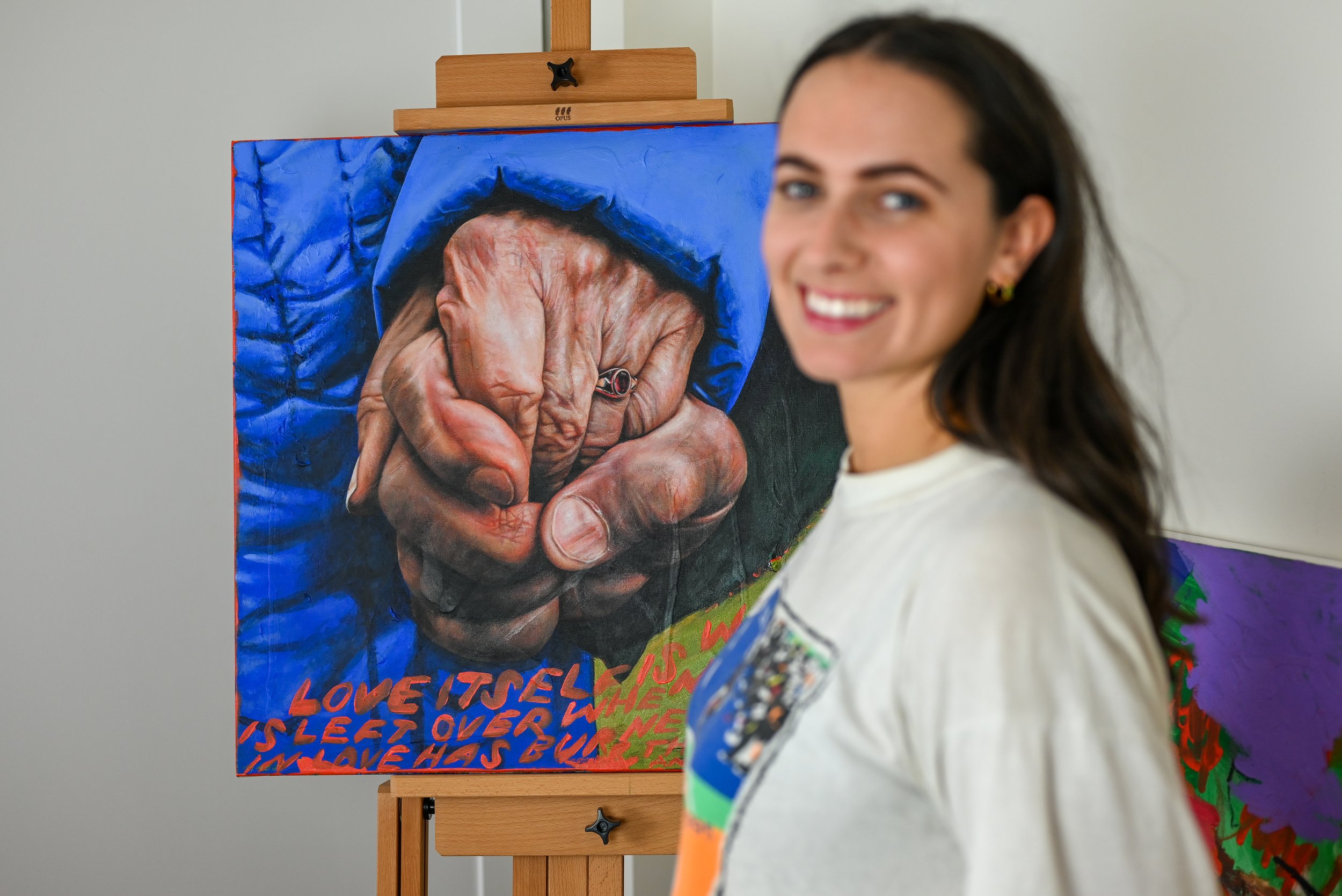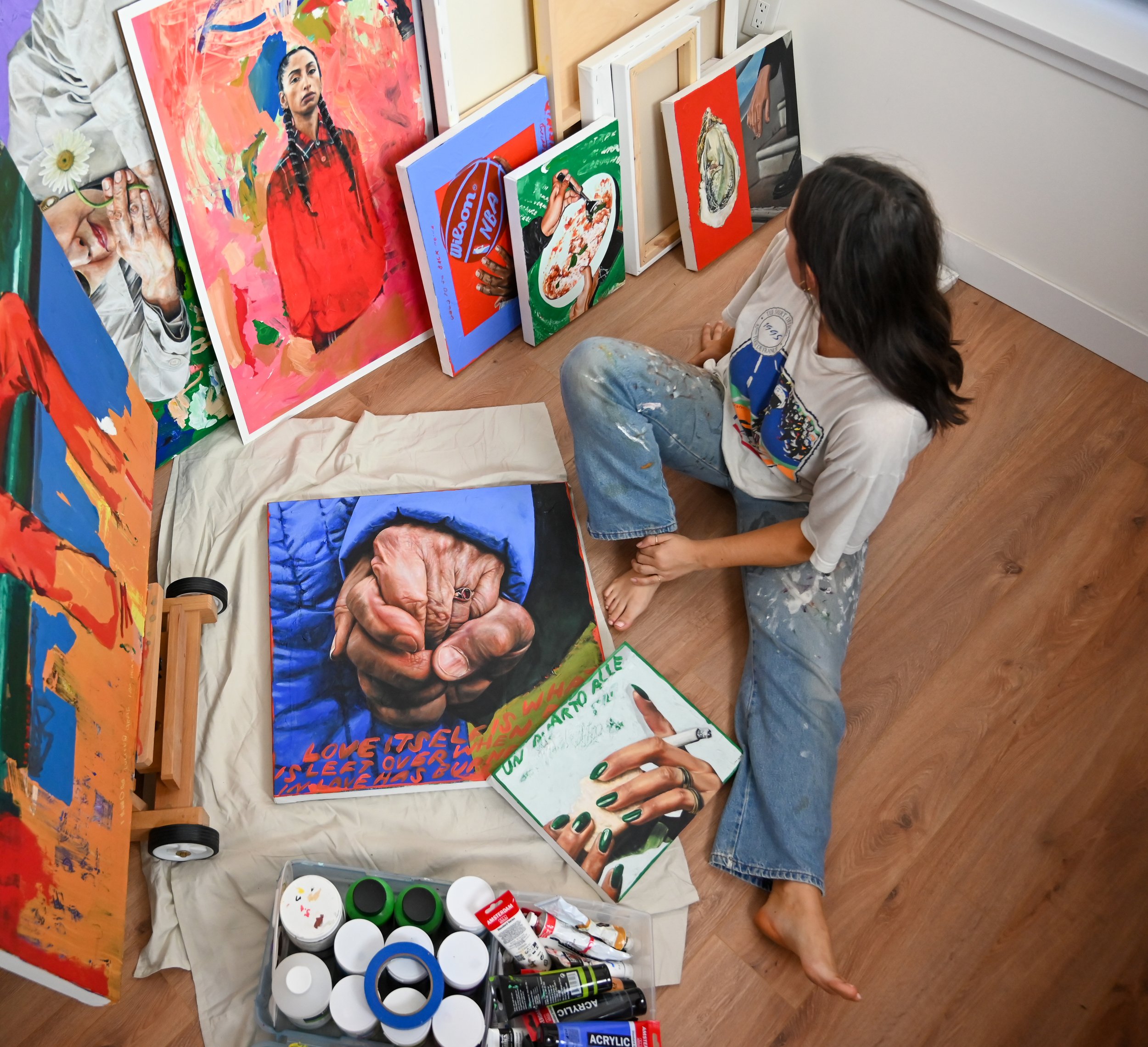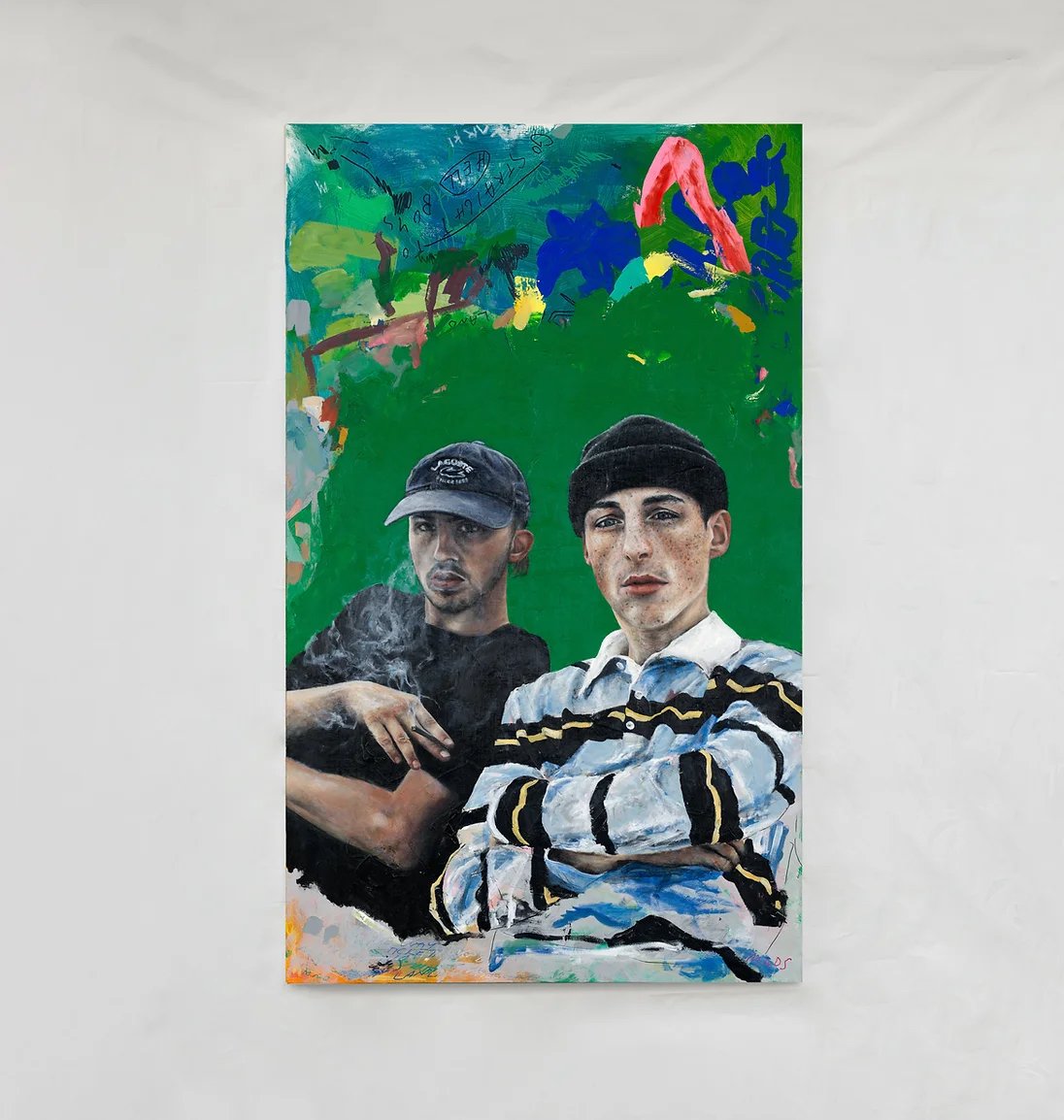10 Questions with Madison Higginbotham
Madison Higginbotham, known as Mads, is a self-taught painter based out of Vancouver, Canada. She was born into a family that cherishes the arts. For good or bad, money wasn’t a driving motivator, but art was. Mads was encouraged to scribble, draw, and paint from an early age. Although this became a self-soothing habit, it hadn’t crossed her mind to make it a career. She busied herself by completing her BA in Corporate Communications with a Graphic Design Certificate and joined the corporate workforce. It wasn’t until years later that Mads picked up a paintbrush again and quickly realized this was the direction she needed to go.
Madison Higginbotham - Portrait
ARTIST STATEMENT
Mads naturally gravitates towards portraiture and figurativism. She believes it’s the most captivating subject to paint. With its inherent mutuality, even the most mundane moments can be portrayed as powerful and beautiful. She looks at these moments as if time has slowed and the perfect soundtrack has been applied. Mads wants to highlight the seemingly monotonous and communicate what she sees, hears and feels. Each piece is intentionally consumed by colour, chaos and scribbling. She looks to capture the viewer’s eye and leave them with a tensional curiosity and appreciation for this mysterious ride we call the human experience.
Madison Higginbotham in her studio
INTERVIEW
Let’s introduce you to our public. Who is MADS in three words?
Easy-going, optimistic and passionate
You are a self-taught painter. How did you develop into the artist you are today? What training and experiences helped you in this process?
I started scribbling from a young age. My family would go on these lengthy month-long road trips and there were few ways to pass the time. One way (pre iPad era) was to put pen to paper. I would sit there for hours on end mimicking my older and more artistic sister’s drawings. This habit grew into a passion for sketching, painting and creating. As I got older, I would take the occasional art class and realized that drawing and painting came naturally to me. It also helped that my family always supported any artistic ambition. Whether we were given lessons in music history, encouraged to read or supporting a friend’s theatre production, the arts took precedence. Because of this inclination and my home environment, I would take on many different artistic projects/commissions. For whatever reason, I would often choose incredibly intricate subject matter, far beyond my skills at the time. The first painting I ever did was from the iconic Sgt. Peppers photoshoot…a vigorous lesson in skin tones and fabric. This forced me to push myself and build my skill set at a young age. Over time, I eventually honed in on painting and developed my own style.
An Ode to Hercules, acrylic on canvas, 48x36 cm, 2022 © Madison Higginbotham
Still here, acrylic on canvas, 24x24 cm, 2023 © Madison Higginbotham
You studied communication and graphic design and worked a corporate job. How do these experiences influence your work as a painter?
I wanted to find a career in which I could create and get a consistent paycheck so I decided to pursue graphic design after completing my BA. Design school ended up being life-changing, it relit the artistic flame inside of me. I gained in-depth knowledge on various design concepts, from colour theory, typography, to layout. I got exposed to designers and artists like Jessica Walsh, Broken Fingaz, Gaetano Pesce, David Shrigley, Angela Bains (my instructor)...I could go on forever. This short period of my time completely changed my life trajectory. It also started my fascination with typography and penmanship. I include writing into almost every painting of mine. Stylistically, there’s nothing I love more than some messy, almost child-like, scribbly text on a community poster, fine art painting, ad campaign, etc.
After design school, I got a full-time job working as an in-house Graphic Designer. Being the only designer at company going through a full rebrand, I learned A LOT. I learned everything from campaign creation, digital ad sets, large-format printing, to navigating the corporate office. The biggest learning curve was realizing that corporate life was not for me. Some people thrive in a well-structured, more regimented, office lifestyle…I am not one of them. I needed more creativity in my work and life. To the dismay of my bank account and partner/landlord, I quit my 9-5 desk job and decided to become a full-time painter. It was and still is a risky move, but I don’t look back with regret. I’ve used all those influences and experiences to become the painter I am today.
Can’t fight the feeling, acrylic on canvas, 40x60 cm, 2022 © Madison Higginbotham
Ultimately, how would you define yourself as an artist? And what, in your opinion, makes you unique?
To put it very simply, I’m a people-person who’s consumed by my love for art. What defines and drives me, is my love for this shared human experience and a person’s individuality. If I had any writing ability, I would be a journalist writing exposés on everyday people. If I had any technical photography skills, I would be photographing everyday people. Painting happens to be my medium, but people would always be my chosen subject matter. I feel like my purpose in life is to connect with people and elevate their story through painting. I want to make marginalized groups, community heroes, everyday people feel comfortable, seen and heard.
Portraiture has and will always be practiced throughout time. It is a powerful way to capture the essence of a being. That’s why millions of artists have done it and millions will continue to do so. I evidently love portraiture and realism, so the question remains, how does one differentiate themselves stylistically speaking? What makes my work my work? The answer can be found in every aspect surrounding the actual portrait. I stay true to the subject’s features and keep the portrait relatively realistic. It’s in the background details that makes my work stand on its own. When you look at my body of work as a whole, you can see the stylistic consistencies: colourful, chaotic, textural, unfinished and scribbly. These are all intentional choices used to best portray who the subject is and to affect the viewer’s emotions and perception.
Let’s talk about your work. You primarily work with painting; why did you choose this medium in the first place?
I was formally trained in the digital art space but longed for getting my hands dirty. If I was a designer in the 80’s, cutting out images or working an old-school letterpress, I think I would have stayed in that industry for longer. But it’s the 21st century and most designers spend their time between an iPad and a computer. I enjoyed this to a certain point but wanted to put my creativity into a physical body of work. I love the vibrance, messiness, malleability of painting. Nothing gives me more joy than scraping thick blobs of paint with a palette knife to texturize a canvas. I also love the ability to transform a space with a single painting. Paintings are unique in that there’s always more to discover, whether it’s a new paint stroke or textural difference. Seeing someone look at a painting from a far, then get up close to examine all the details is a life-affirming feeling. I plan on painting for as long as I physically can.
Meeting of minds, acrylic on canvas, 16x20 cm, 2023 © Madison Higginbotham
Mezzanotte, acrylic on canvas, 12x16 cm, 2023 © Madison Higginbotham
In your statement, you mention how you gravitate towards portraiture and figurativism. Why did you choose these specifically? And what do they represent for you?
You’ve probably gathered this by now, but my favorite subject matter to consume always involves people. Whether I’m reading, watching a documentary, walking through a gallery, I always find I gravitate towards content/art focused on individual people. Specifically, portraiture has always strongly impacted me. I remember seeing the work of photographers like Annie Leibovitz and Kwame Brathwaite and being so captivated. I’ve always been drawn to faces, hands, etc. Whether I was doodling in class or sourcing out commission work, people have always become the subject matter. Something about the shared experience of being a human on this planet, yet feeling and seeing the differences of individuality, speaks to me.
What messages are you trying to communicate with your art? And what do you think differentiates your approach from others?
I paint everyday people, everyday moments, doing everyday things because there’s power in the concept of “everyday.” Each painting looks to highlight these moments in a human’s life, from commuting on the subway, taking a cig break at lunch, to eating greasy leftovers after a night out. Without being too on the nose, I want to communicate what you would see, hear and feel as if it was a scene in a film. Do you ever feel if you added the right soundtrack to all of these small moments in our lives, they would be vastly more significant and beautiful? That’s how I see the world and that’s how I aim to create. Instead of painting every background detail, I choose to communicate the mood through colour, abstract shapes, words and scribbled lyrics. I go as far to create a playlist for each painting. It’s important for me that these background details and musical influence highlight the beauty and power of these everyday moments.
Fernanda, acrylic on canvas, 36x60 cm, 2023 © Madison Higginbotham
Lately, there has been a huge focus on the so-called deskilled painting. Have you ever heard about it? And what do you think about it?
Yes, I have. And as someone who spends hours and hours putting brush to canvas, I understand why deskilled painting can be polarising. I, however, love this style. Some of my favourite artists right now would fall under this category and I find their work especially moving. I admire the scribbly freedom, child-like imagination and simplistic execution. Whether I’m looking at the work of a child or a well-established artist, there’s beauty in the style nonetheless. You can see a lot of my background work includes free-form strokes, scribbling, incoherent writing and this often becomes my favorite part of the paintings. I believe the addition of these deskilled details elevate and differentiates my work.
Is there anything else you want to experiment with or incorporate into your practice?
I’m at the very early stages of my art career and I’m looking forward to experimenting and incorporating many different approaches into my practice. I could write a thousand words on what I want to do, all the ideas that pop into my head, but I’ll try to summarize appropriately.
From a micro level, I would like to play role in every step, from concept to finished painting. I want to wear the hat of creative director, photographer and painter. At this point, I’ve been reaching out and working with photographers but I would like to develop my photography skills. I would also like to get to know my subjects more. I’ve started opening up for commission work and I’ve found this to be very rewarding. I get to know the subject on a deeper level and this has elevated my work greatly. Down the road, I would like to reach out to local communities and have them decide who I paint, in a sort of nomination-like fashion. I want to paint community members who are working behind the scenes to make small but significant changes to their community.
From a macro level, I want to transcend the boundaries of the traditional canvas. I want to work with more obscure objects that really transcend a space. A few ideas come to mind: designing large-scale/highly-visible banners that highlight community members, transforming boring public bathroom stalls into works of art, to painting a series of Panton chairs for display or an event. I’m excited to look back at my art career and see an almost Picasso-like progression, starting with realism and growing into my own perception of reality. This could be seen in how I paint, who I paint and what I paint on. I hope to harness my skillset and push the boundaries of my own style.
Ungdomskultur, acrylic on canvas, 36x60 cm, 2023 © Madison Higginbotham
And lastly, what are your plans for the future? Do you have any exhibition or collaboration you would like to share with our readers?
My gallery season is officially done for 2023. I just finished showing my “Good Pairings” series. At the moment, I’m taking on a few commissions and starting to build my next series. I’m hoping to complete my next body of work by Summer 2024. This series will be called “Human-Made: The Art of Robbing Creative Identity.” It will be a solo show juxtaposing human-made art against AI art. What appear as subtle differences in quality and form will eventually lead to the theft of creative identity. It’s November 2023 and we’ve already seen the art thief slowly creep its artificial head out. Scripts are being regenerated in the “tone of Sarah Silverman” and Hank Williams is singing Straight Outta Compton. AI is here to stay and will become the biggest threat to established creatives. Within seconds, an artist's voice and experience can be robbed, mimicked and reconfigured. This show aims to expose the dangers of AI in the creative field and highlight the value of art being human-made. Every painting will highlight a human experience, from a child looking into the sun and feeling its blinding warmth, an over-worked businessman nodding off to the subtle repetition of subway tracks, to someone holding their partner’s hand and feeling the blood-pumping warmth between their palms. Each human-made piece will be contrasted by an AI duplicate. From afar, both depict the same subject in a similar style. But up close, you can see the human-made quality, the brush strokes, the mistakes, the layering. As the show progresses, questions will be asked. Which holds worth? Who will support human-made? Will the middle-class economy embrace an immoral cheap alternative? Who will partake in robbing creative identity?
Artist’s Talk
Al-Tiba9 Interviews is a promotional platform for artists to articulate their vision and engage them with our diverse readership through a published art dialogue. The artists are interviewed by Mohamed Benhadj, the founder & curator of Al-Tiba9, to highlight their artistic careers and introduce them to the international contemporary art scene across our vast network of museums, galleries, art professionals, art dealers, collectors, and art lovers across the globe.
























